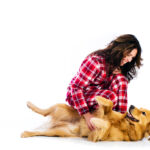Why Is My Dog So Skittish
As a dog owner, you may have noticed that your furry friend can sometimes be skittish. It’s not uncommon for dogs to display signs of fear or anxiety in certain situations. But why is your dog so skittish? In this article, we’ll explore some of the reasons why dogs can be skittish and what you can do to help them feel more comfortable.
Possible Causes of Skittishness in Dogs
1. Genetics
Some breeds are more prone to anxiety than others. For example, many small dog breeds like Chihuahuas are known for being nervous and easily frightened. If your dog comes from a breed with a predisposition to anxiety, it might be more susceptible to skittishness.
2. Trauma
Dogs that have experienced trauma in the past may be more likely to exhibit signs of fear or anxiety. This could include abuse, neglect, or even a traumatic event like a car accident or natural disaster. If your dog has a history of trauma, it’s important to work with a professional trainer or behaviorist to help them overcome their fears.
3. Lack of Socialization
Puppies that don’t receive proper socialization during their critical development period (around 3-14 weeks) may be more likely to develop fears and phobias later in life. Exposure to different people, animals, and environments during this time can help puppies learn how to cope with new experiences.
4. Medical Issues
In some cases, skittishness in dogs can be caused by underlying medical issues like pain or an imbalance in hormones. It’s always a good idea to have your dog examined by a veterinarian if you notice any sudden changes in behavior.
5. Loud Noises
Many dogs are afraid of loud noises like thunderstorms, fireworks, and vacuum cleaners. This fear can lead to skittish behavior like trembling, panting, and hiding.
6. Separation Anxiety
Dogs that suffer from separation anxiety may become skittish when left alone or when their owner is out of sight. This can lead to destructive behavior, excessive barking, and other signs of distress.
What You Can Do to Help Your Skittish Dog
1. Provide a Safe Space
Create a safe space for your dog where they can retreat when they feel anxious. This could be a crate, a cozy bed in a quiet room, or even a covered den-like area in your yard.
2. Use Positive Reinforcement
Reward your dog for calm behavior with treats, praise, and attention. This will help them associate calmness with positive things and encourage them to remain calm in stressful situations.
3. Avoid Punishment
Never punish your dog for being skittish or fearful. Punishment can make the problem worse and damage your relationship with your pet.
4. Desensitization and Counterconditioning
Gradually expose your dog to the things that make them skittish in a controlled environment. Start with low-intensity versions of the trigger (like distant thunder) and gradually increase the intensity as your dog becomes more comfortable.
5. Seek Professional Help
If your dog’s skittish behavior is severe or affecting their quality of life, it’s important to seek professional help from a veterinarian or certified trainer/behaviorist.
In conclusion, skittishness in dogs can have many different causes, but there are things you can do to help your furry friend feel more relaxed and comfortable. With patience, positive reinforcement, and professional guidance if necessary, you can help your skittish dog overcome their fears and live a happy, healthy life. So next time you see your pup trembling at the sound of thunder or hiding under the sofa during fireworks season, remember that there are ways to help them feel better ¨C and maybe crack a joke to lighten the mood!



